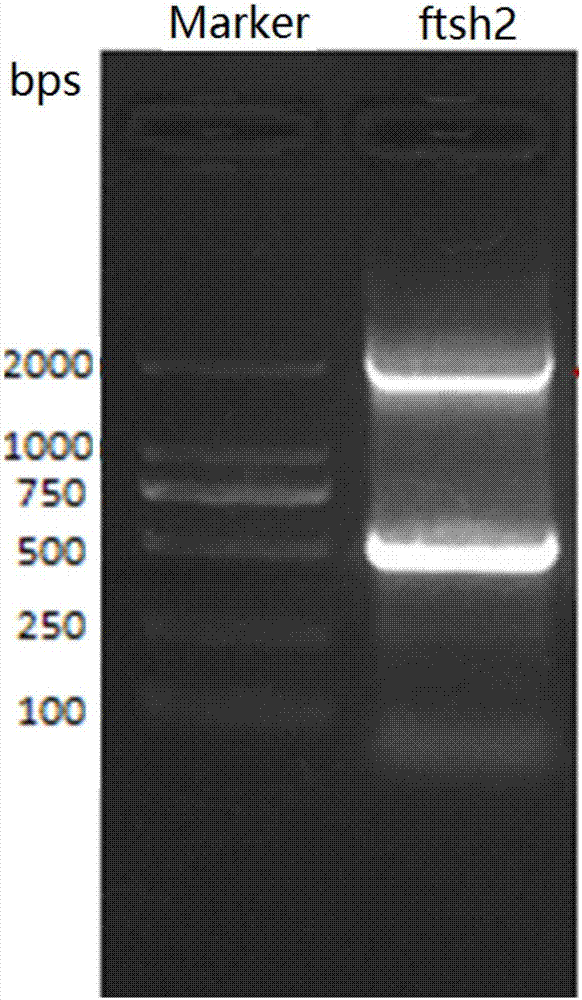Anti-FtsH2 protein monoclonal antibody and application thereof
A monoclonal antibody, antibody technology, applied in the field of agricultural biology
- Summary
- Abstract
- Description
- Claims
- Application Information
AI Technical Summary
Problems solved by technology
Method used
Image
Examples
Embodiment 1
[0027] Cloning of embodiment 1 wheat ftsh2 gene and preparation of recombinant FtsH2 antigenic protein
[0028] 1) Take plant samples
[0029] Potted Jimai 418 (Institute of Grain and Oil Crops, Hebei Academy of Agriculture and Forestry Sciences) was subjected to salt stress treatment from heading to flowering stage, about 0.1 g of flag leaf leaves three days after treatment were taken, ground into powder with liquid nitrogen, and 0.5 mL of total plant RNA was added Extraction reagent (Tiangen Biochemical Technology (Beijing) Co., Ltd.), shake until thoroughly mixed. Place at room temperature for 5 minutes, centrifuge at 12,000 rpm for 2 minutes at 4°C, and transfer the supernatant to a new RNase-free centrifuge tube. Add 0.1mL 5M NaCl (prepared with DEPC), mix gently, then add 0.3mL chloroform, and mix evenly by inversion. Centrifuge at 12,000 rpm for 10 min at 4°C, transfer the upper aqueous phase to a new RNase-free centrifuge tube, add isopropanol of an equal volume to...
Embodiment 2
[0036] The establishment of embodiment 2 hybridoma cell lines and clone screening
[0037] 1) Animal immunity
[0038] The recombinant protein expressed and purified in Example 1 was emulsified with complete Freund's adjuvant (Sigma Company), immunized 4-6 weeks old female Balb / c mice (Beijing Weitong Lihua Experimental Animal Technology Co., Ltd.), and injected subcutaneously in the abdomen 6 points per mouse, the dose is 60 μg / mouse. Immunization was boosted once every 14 days, and emulsified with Freund's incomplete adjuvant (Sigma Company) at a dose of 30 μg per mouse. 7 days after the third booster immunization, indirect ELISA (wavelength 450nm) was used to detect the multi-antibody titer of the anti-immunogen in the mouse serum. The mouse with the highest titer was immunized by intraperitoneal injection. 50 μg / only to obtain mice that reached the standard of immunity.
[0039] 2) cell fusion
[0040] Aseptically prepare the mouse splenocyte suspension that reaches ...
Embodiment 3
[0043] Example 3 Preparation of Anti-FtsH2 Protein Monoclonal Antibody by Ascites Induction Method and Characterization of Monoclonal Antibody
[0044] 1) Ascites preparation
[0045] The 30749-22 hybridoma cell line was cultured to the logarithmic growth phase, washed with serum-free medium and suspended, and counted to 5×10 5 , 1ml. The suspended two kinds of cells were intraperitoneally injected into mice sensitized with paraffin oil. Ascites collection was started 7 days later. The removed ascites was centrifuged at 4000rpm for 10min at 4°C. Carefully suck out the ascites in the middle and collect in a centrifuge tube, and store at -20°C. Antibody was purified from ascitic fluid by HiTrap rProtein A FF (GE Company) affinity chromatography according to the instructions. The purity was identified by SDS-PAGE gel, and the concentration was determined by Bradford method. Purified antibodies were stored at -20°C.
[0046] 2) Subclass identification
[0047] Dilute coa...
PUM
| Property | Measurement | Unit |
|---|---|---|
| molecular weight | aaaaa | aaaaa |
Abstract
Description
Claims
Application Information
 Login to View More
Login to View More - R&D
- Intellectual Property
- Life Sciences
- Materials
- Tech Scout
- Unparalleled Data Quality
- Higher Quality Content
- 60% Fewer Hallucinations
Browse by: Latest US Patents, China's latest patents, Technical Efficacy Thesaurus, Application Domain, Technology Topic, Popular Technical Reports.
© 2025 PatSnap. All rights reserved.Legal|Privacy policy|Modern Slavery Act Transparency Statement|Sitemap|About US| Contact US: help@patsnap.com



